For ages, astronomers have been intrigued by the notion of uncovering exoplanets – planets outside our Solar System. Thus far, astronomers have found over 5,300 of them with new discoveries coming in at an astounding rate.
In the quest to locate these elusive entities, two primary techniques have emerged: indirect and direct. While indirect means have historically prevailed, a recent direct imaging approach utilizing the Gaia space observatory has yielded captivating possibilities.
Indirect methods infer exoplanet existence by examining their impacts on their parent stars. These effects include fluctuations in position or brightness, unveiling the presence of a planet orbiting around the star. This approach has been highly successful, with most exoplanets detected by astronomers using these means.
Direct imaging, on the other hand, involves actually seeing the planet via telescopes such as the Hubble or Keck Observatory. This technique provides information such as the composition of atmospheres around planets and their temperatures but has been more demanding due to the requirement for the planet to be substantially more massive than Jupiter, the largest planet in our Solar System, and considerably separated from its parent star. To date, only about 20 exoplanets have been captured through direct imaging.
A massive alien planet 15 times larger than Jupiter
However, an international team of astronomers was able to discover another exoplanet by using a combination of both. The group used the Gaia mission to search for stars that “wobble” in the sky. They then leveraged the Hipparcos-Gaia Catalogue of Accelerations, a database combining data from Gaia’s star-mapping missions, which provides a 25-year baseline for comparing precise star positions, known as astrometry.
Using this database, astronomers spotted several stars that seemed to alter position in the night sky in a manner suggesting the presence of a giant planet orbiting each one. They then employed the Subaru Telescope on Mauna Kea, Hawaii, and gathered data using the Subaru Coronagraphic Extreme Adaptive Optics (SCExAO) instrument coupled with the Coronagraphic High-Resolution Imager and Spectrograph (CHARIS) instrument.
The outcome was the discovery of HIP 99770 b, located some 132 light-years away. This planet is more than 15 times the mass of Jupiter and orbits a star almost twice as massive as the Sun.

“(The find) demonstrates that an indirect method sensitive to a planet’s gravitational pull can tell you where to look and exactly when to look for direct imaging,” said lead study author Thayne Currie, based at the National Astronomical Observatory of Japan in Hilo, Hawaii and the University of Texas-San Antonio. “So, I think that’s really exciting.”
Although the planet’s orbit is more than three times larger than Jupiter’s orbit around the Sun, it receives nearly the same amount of light since its host star is far more luminous than the Sun.
“This is sort of a test run for the kind of strategy we need to be able to image an Earth,” Currie said.
This newly developed approach of using astrometry to identify stars with planets has the potential to significantly increase the number of exoplanets imaged directly. Rather than blindly targeting stars, astronomers can now focus their search on stars more likely to have planets, increasing their chances of success.



